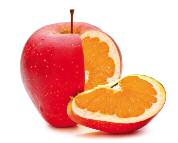Mixed Breed
I was once told a charming story about a Chassidic rebbe, whose name I’ve conveniently forgotten, who prepared rigorously for every mitzvah. On erev Sukkos he sat up all night, staring at his esrog and lulav in the glass-enclosed case in his dining room, joyously waiting for the exact moment he could make the berachah. When the first rays of light came through the window, he was so excited that he thrust his hand through the glass door of the case, shattering the pane to grab the arba minim!
Be honest. Did you think, “Wow! I wish I had done that”? I didn’t. This is the kind of tale that leaves me wondering: a) since he was sitting there all night, why didn’t he think of opening the glass door hours ago?; and b) now that his hand is all bloody, he’ll have to stop the bleeding before he can even take hold of that esrog.
I’m told that in some quarters, my reaction borders on sacrilege. It’s not that I don’t see the beauty; it’s that some cold logic in my brain pulls the plug. I know what it is, too. I was born of mixed parentage: my mother was from a Chassidic family; Dad was a Litvak.
It was a marriage that could only happen in America. Here, in that bubbling melting pot of the 1930s, somewhere between the Williamsburg Bridge and Houston Street, all bets were off on maintaining clan loyalties. Immigrant kids were assimilating in droves, and you were lucky to find someone who would keep a kosher home.
“How can it be,” she wondered in a stage whisper, “that my Poppa’s einikle doesn’t understand a few words of mama loshon?”
So the Litvish rav reconciled to marrying his son to the daughter of a Chassidic grocer, and the invitations went out. Though the prospective machutanim did have genuine respect for each other, legend has it that the wedding was almost cancelled in the planning stages when the rebbetzin announced that she and her husband intend to walk their son to the chupah—together! It was only through the exemplary negotiating talents of my mother that the two sides worked out a series of compromises that made the Treaty of Versailles look like child’s play.
There follows the saga of how Mom choked down her first Pesach kneidlach at her in-laws’ house, but overall, the transition was rather smooth. As both bride and groom essentially had grown up in America, it was understood that they would not speak Yiddish—with neither a Litvish dialect nor a Chassidish one—at home. Except for an occasional barb thrown lovingly by my father at his “Galicianer shver,” and the recitation of the Motzaei Shabbos prayer “Gott fun Avrohom” (which I dutifully learned to garble), Yiddish was absent from our household. This fact did not stop my mother from being appalled some twenty years later, when she offhandedly used some Yiddish expression in my presence and was met by my blank stare. “How can it be,” she wondered in a stage whisper, “that my Poppa’s einikle doesn’t understand a few words of mama loshon?”
Go figure.
Let’s just say I grew up with dual identities. One side of me gravitates to my zayda’s Chassidishe Shabbos zemiros, with every “yubba-bubba-boy-boy” inexplicably filling me with utter delight. The other side of me recoils with horror at an invitation to make the Lag B’Omer scene at Meron.
You could say I am pure American—a mixed breed in a land where inconsistency is the order of the day. In America, it’s ok if you’re a little bit this and a little bit that: you can belt out Modzitzer niggunim and still wallow in gebrokts. And I have met many like me. Even if their ancestries were more uniform than mine, most people in my world have customs that are a pale version of their families’ original heritage. They’ve adopted common American practices, and overall have made peace with hybrid Judaism.
In ancient times, a Benjaminite could never sneak into a Zevulonite party unnoticed. And back then, that individuality served a purpose. But today’s blurring of the lines has yielded a Universal Jew, and that must serve some Divine purpose too. No one can deny that though our nation is made up of numerous religious groups, we are nonetheless united by one Torah. I may never break through a glass door to do a mitzvah, but I have learned to respect someone who would.
I’m not for a moment advocating abandoning family traditions. Yet living in a world where the marriage of a Sephardi to an Ashkenazi, or a Yekke to a Bucharian, is no longer shocking but a real possibility, can yield unprecedented benefits. For it’s been said that, like Queen Esther, the Mashiach will be of a background so indiscernible that every group in Klal Yisrael will smile and say, “He’s surely one of us.”
I hazard to guess that by then we’ll realize that there is only one “us.” At that point, as the prophets foretold, Jews will emerge from unexpected corners of the earth and from every sector of Judaism—wearing different hats, perhaps—but no one will care about the nuances. And as a nation of mixed breeds—with a powerful ahavas Yisrael that we can now barely imagine—we will be whole once again.
Charlotte Friedland is a former editor of Jewish Action and also served as a book editor at Mesorah Publications, Ltd. She currently has her own writing/editing/ consulting firm in Spring Valley, New York.

